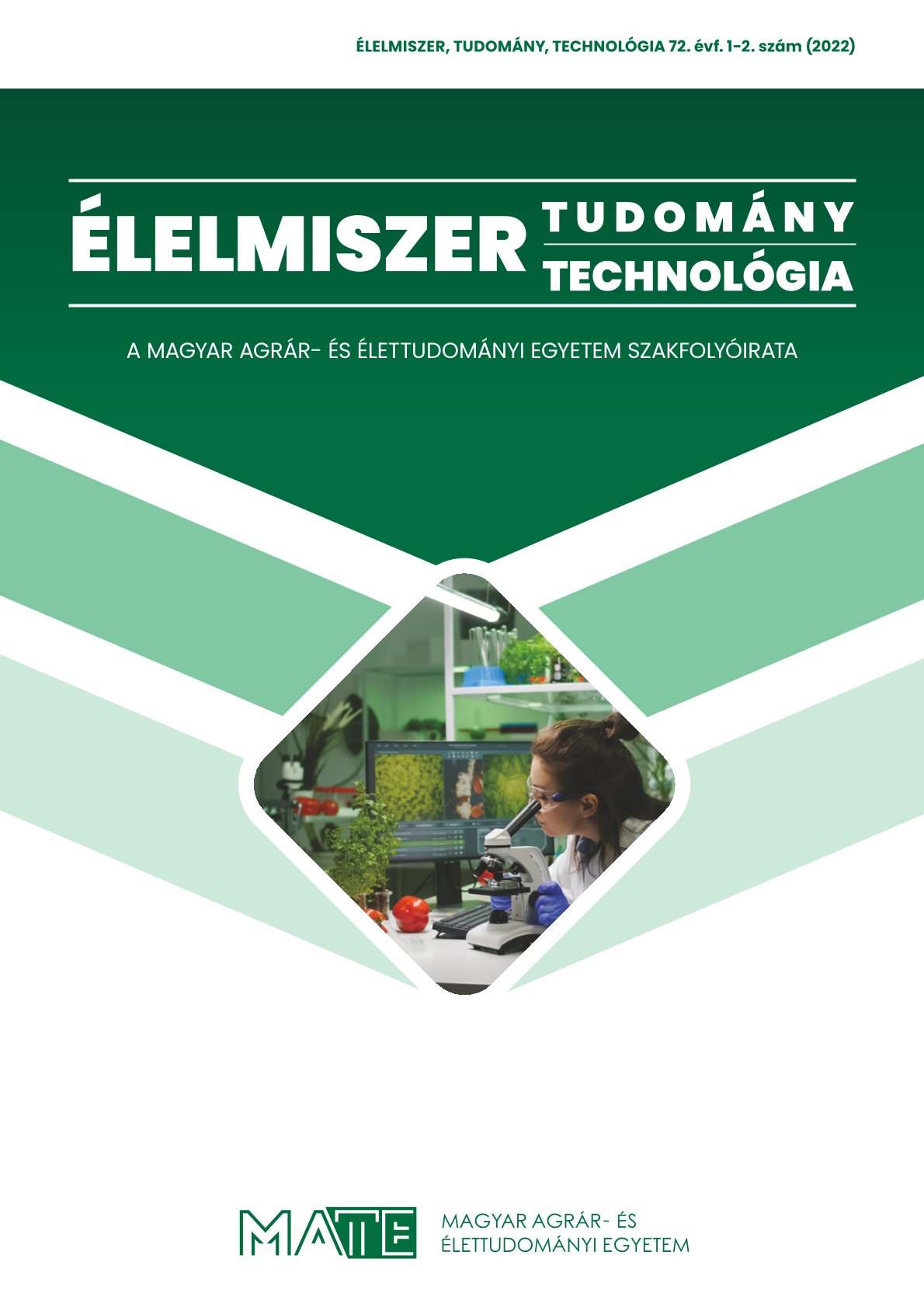Overview of animal species-specific testing procedures based on protein and DNA detection
Keywords:
animal species identification, protein detection, DNA detectionAbstract
In the investigation of meat and meat products, the identification of animal species and the detection of foreign proteins (plant-derived and non-meat animal proteins) may be important, taking into account food safety and quality assurance considerations. The instrumental approach to origin testing is justified by the fact that in the case of minced meat, frozen block meat and various meat products, the species can often no longer be identified organoleptically. In addition to economic reasons, the identification of meat is also important from health, religious and animal welfare points of view. A wide range of food analytical methods can be used to determine the speciesspecific origin of meats. Commonly used methods are based on the analysis of proteins or DNA, which we review in our article.
References
Ballin, N.Z., Vogensen, F.K., Karlsson, A.H. (2009): Species determination – Can we detect and quantify meat adulteration? Meat Science, 83:165–174. https://doi.org/10.1016/j.meatsci.2009.06.003
Cao, Y., Zheng, K., Jiang, J., Wu, J., Shi, F., Song, X., Jiang, Y. (2018): A novel method to detect meat adulteration by recombinasepolymerase amplification and SYBR green I. Food Chem., 266:73–78. https://doi.org/10.1016/j.foodchem.2018.05.115
Chen, T.Y., Chen, N.H., Lin, W.F., Hwang, K.L., Huang, Y.C., Hwang, D.F. (2010): Identification of causative fish for a food poisoning in Taiwan by using SDS-PAGE technique. Journal of Marine Science and Technology, 18:593-596. https://doi.org/10.51400/2709-6998.1924
Csehi, B., Szerdahelyi, E., Pásztor-Huszár, K., Salamon, B., Tóth, A., Zeke, I., Jónás, G., Friedrich, L. (2016): Changes of protein profiles in pork and beef meat caused by high hydrostatic pressure treatment. Acta Alimentaria, 45:565-571. https://doi.org/10.1556/066.2016.45.4.14
Ekici, K. (2008): The species identification of raw meat with sds-page technique. Indian Vet. J., 85:1193-1195. Farag, M.R., Imam, T.S., Dhama, K. (2015): Identification of some domestic animal species (camel, buffalo and sheep) by PCR-RFLP analysis of the mitochondrial cytochrome b gene. Adv. Anim. Vet. Sci., 3(2): 136-142. https://doi.org/10.14737/journal.aavs/2015/3.2.136.142
Goodwin, P. (1992): Immunoassay methods for animal specification. 33-39. p. In Morgan M.A., Smoith C.J., Williams P.A. (eds) Food safety and quality assurance: application of immunoassay system. London: Elsevier Sci.Publ.
Griffiths, N.M., Billington, M.J. (1984): Evaluation of an enzyme-linked immunosorbent assay beef blood serum to determine indirectly the apparent beef content of beef joints and model mixtures. Journal of Science of Food and Agriculture, 35:909-914. https://doi.org/10.1002/jsfa.2740350816
Hajós, Gy. (1993): Elektroforézis és alkalmazása az élelmiszerfehérjék elválasztásában. Élelmiszervizsgálati Közlemények, 39:6-26.
Khorana, H.G. (1971): Study on polynucleotides: repair replication of short synthetic DNA’s as catalyzed by DNA polymerases. Journal of Molecular Biology, 56:341.
Kissenkotter, J., Bohlken-Fascher, S., Forrest, M.S., Piepenburg, O., Czerny, C.P., Abd El Wahed, A. (2020): Recombinase polymeraseamplification assays for the identification of pork and horsemeat. Food Chem., 322:126759. https://doi.org/10.1016/j.foodchem.2020.126759
Lungström, I., Engvall, E., Ruitenberg, E.J. (1974): ELISA -Enzyme–linked immunosorbent assay- in serological diagnosisi of Trichinella spiralis infection. In: Proceedings of third international congress of parasitology, Vol I. II. III. Vienna: Facta Publications, 1204-1205.
Mane, B.G., Mendiratta, S.K., Tiwari, A.K. (2009): Polymerase chain reaction assay for identification of chicken in meat and meat products. Food Chem., 116(3):806–810. https://doi.org/10.1016/j.foodchem.2009.03.030
Martin, R., Azcona, J.I., Casas, C., Hernandez, P.E., Sanz, B. (1988a): Sandwich ELISA for detection of pig meat in raw beef using antisera to muscle soluble proteins. Journal of Food Protection, 51:790-794. https://doi.org/10.4315/0362-028x-51.10.790
Martin, R., Azcona, J.I., Casas, C., Hernandez, P.E., Sanz, B. (1988b): A sandwich ELISA for detection of horse meat in raw meat mixtures using antisera to muscle soluble proteins. Meat Science, 22:143-153. https://doi.org/10.1016/0309-1740(88)90088-5
Martin, R., Azcona, J.I., Tirmo, J., Hernandez, P.E., Sanz, B. (1988c): Detection of chicken meat in raw meat mixtures by a sandwich enzyme immunoassay. Int. Journal of Food Science and Technology, 23:303-310. https://doi.org/10.1111/j.1365-2621.1988.tb00584.x
Martin, R., Wardale, R.J., Jones, S.J., Hernandez, P.E., Patterson, R.L.S. (1991): Monoclonal antibody sandwich ELISA for the potential detection of chicken meat in mixtures of raw beef and pork. Meat Science, 30:23-31. https://doi.org/10.1016/0309-1740(91)90031-k
Meyer, R., Höfelein, C., Lüthy, J., Candrian U. (1995): PCRRLFP: A simple method for species identification in food. Journal of AOAC, 78(6):1542-1551. https://doi.org/10.1093/jaoac/78.6.1542
Morales, P., Garcia, T., Gonzales, I., Martin, R., Sanz, B., Hernandez, P.E. (1994): Monoclonal antibody detection of porcine meat. Journal of Food Protection, 54:146-149. https://doi.org/10.4315/0362-028x-57.2.146
Mullis, K.B., Fred, A., Faloona, F.A. (1987): Specific synthesis of DNA in vitro via a polymerase-catalyzed chain reaction. 335-350 p. In: Wu, R. (ed.): Methods in Enzymology. Recombinant DNA. Part F. New York: Elsevier Inc., 628 p. https://doi.org/10.1016/0076-6879(87)55023-6
Rodrigez, M.A., Garcia, T., Gonzales, I., Hernandez, P.E., Martin, R. (2005): TaqMan real-time PCR for the detection and quantitation of pork in meat mixtures. Meat Science, 70:113-120. https://doi.org/10.1016/j.meatsci.2004.12.005
Sawyer, J., Wood, C., Shanahan, D., Gout S., Mcdowell D. (2003): Real-time PCR for quantitative meat species testing. Food Control, 14:579-583. https://doi.org/10.1016/s0956-7135(02)00148-2
Sherikar, A.T., Karkare, U.D., Khot, J.B., Jayaras, B.M., Bhilegaonkar, K.N. (1993): Studies on thermostable antigens production of species-specific antiadrenal sera and comparison of immunological techniques in meat speciation. Meat Science, 33:121-136. https://doi.org/10.1016/0309-1740(93)90099-4
Szántó-Egész, R., Jánosi A., Mohr, A., Szalai, G., Koppányné Szabó, E., Micsinai, A., Sipos, R., Rátky, J., Anton, I., Zsolnai, A. (2016): Breed-specific detection of mangalica meat in food products. Food Anal. Methods., 9:889–894. https://doi.org/10.1007/s12161-015-0261-0
Teletchea F., Maudet C., Hanni C. (2005): Food and forensic molecular identification: update and challenges. Trends in Biotechnology. 23(7):359-366. https://doi.org/10.1016/j.tibtech.2005.05.006
Zhu, P., Gao, W., Huang, H., Jiang, J., Chen, X., Fan, J., Yan, X. (2018): Rapid detection of Vibrio parahaemolyticus in shellfish by real-time recombinase polymerase amplification. Food Analytical Methods. 11(8):2076-2084. https://doi.org/10.1007/s12161-018-1188-z
Downloads
Published
Issue
Section
License
Copyright (c) 2022 Jánosi Anna, Koppányné Szabó Erika, Némethné Szerdahelyi Emőke

This work is licensed under a Creative Commons Attribution-NonCommercial-NoDerivatives 4.0 International License.


